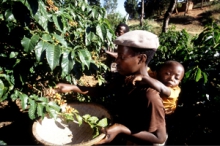New policies needed to promote agroforestry
New policies needed to promote agroforestry
New policies needed to promote agroforestry |
||
Neglected sector is crucial to livelihoods and food security of millions |
||

Young boy with child on his back harvesting coffee berries in Malawi. Smallholders benefit from integrating coffee trees and food crops.
5 February, 2013, Rome – Millions of people could escape poverty, hunger and environmental degradation if countries put more effort into promoting agroforestry, an integrated approach combining trees with crop or livestock production, FAO said today. The agroforestry sector is a significant source both of local commodities such as fuelwood, timber, fruit and fodder for livestock as well as global ones such as coconut, coffee, tea, rubber and gum. Almost half the world’s agricultural land has at least 10 percent tree cover, making agroforestry critical to the livelihoods of millions. Advancing agroforestry In a new guide published today and aimed at decision-makers, key policy advisors, NGOs and governmental institutions, FAO shows how agroforestry can be integrated into national strategies and how policies can be adjusted to specific conditions. The policy guide provides examples of best practices and success stories, as well as lessons learned from challenges and failures. “In many countries the potential of agroforestry to enrich farmers, communities and industry has not been fully exploited,” said Eduardo Mansur, Director of FAO’s Forest Assessment, Management and Conservation Division. “Despite the numerous benefits of agroforestry, the sector is largely hampered by adverse policies, legal constraints and lack of coordination between the sectors to which it contributes, namely, agriculture, forestry, rural development, environment and trade.” New opportunities provided by agroforestry are emerging, for example, within the miombo woodlands of central, eastern and southern Africa, which cover three million square kilometers over 11 countries and contribute significantly to the livelihoods of some 100 million low-income people. Among these new opportunities is the potential to curb greenhouse gas emissions by slowing forest conversion to farmland and to sequester carbon in trees on farms, as a result of the financial incentives offered by carbon trade and the REDD+ initiative. Similarly, the expansion of natural regeneration of over five million hectares of dry degraded land in Niger will contribute to mitigating climate change and increase rural income. Policy action The guide provides ten major tracks for policy action, including: raising awareness of agroforestry systems to farmers and the global community; reforming unfavourable regulations in forestry, agricultural and rural codes; and clarifying land-use policy regulations. The latter does not necessarily mean formal land titling. Research has found that some customary forms of tenure provide the security to plant trees, while reducing the formalities and costs of administration. Providing environmental services Farmers introducing trees on farms should be rewarded for the ecosystem services they provide to society through financial or other incentives in the form of grants, tax exemptions, cost sharing programmes, microcredits or delivery in kind, especially extension services and infrastructure development, according to the guide. Long-term credit is also crucial, as benefits to farmers planting trees reach them only after some years. The value of carbon sequestered and other environmental services provided by the trees could even be applied to paying the interest. In Costa Rica, a national forestry financing fund assigned in 1996 by law to subsidize forestry activities was extended in 2001 and 2005 to agroforestry systems combining crops, trees and cattle. Over the last eight years, more than 10,000 contracts have been signed for agroforestry, which resulted in planting of more than 3.5 million trees on farms. The guide was developed by FAO in cooperation with the World Agroforestry Centre (ICRAF), the Tropical Agricultural Research and Higher Education Centre (CATIE) and the Agricultural Research Centre for International Development (CIRAD).
Source : FAO
|
||

